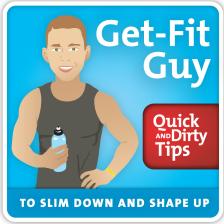How to Vary Your Workouts for the Best Results
When it comes to varying your workouts, how do you know what to change, and when? Get-Fit Guy breaks it down and explains what’s most important to change: your entire workout, your exercises, or your intensity. Plus, get look at a sample week of his pro routines.
Ben Greenfield
Listen
How to Vary Your Workouts for the Best Results

Simply put, the SAID principle, which stands for “Specific Adaptation to Imposed Demands,” is based on the common sense idea that your body eventually adapts to the demands that are placed on it, and because of this, you must constantly throw curveballs at your body through workout variations, exercise variations, and intensity variations.
But when it comes to varying your workouts, how do you know what to change, and when to change it? And what is more important to alter – your entire workout, your exercises, or your intensity?
Why You Need to Change Your Exercises
A recent study published in the Journal of Strength and Conditioning Research looked into this very question.
In the study, researchers looked at the effects of 4 different training methods on the muscle responses of the quadriceps leg muscles and the maximal strength in the back squat. During a 12-week time period, they split study participants into 5 different groups:
- Group 1 did Constant Intensity and Constant Exercise (CICE), in this case, 8 repetitions of a squat exercise.
- Group 2 did Constant Intensity, Varied Exercise (CIVE), performing the squat, deadlift, lunge, and leg press exercises, also with 8 repetitions.
- Group 3 did Varied Intensity, Constant Exercise (VICE), here, a squat exercise with variations of 6-10 repetitions.
- Group 4 did Varied Intensity, Varied Exercise (VIVE), performing the squat, deadlift, lunge, and leg press exercises with variations of 6-10 repetitions.
- Group 5 was either unlucky or lucky, depending on how you look at it – this was a control group that did no training at all.
The results showed that muscle increases were actually not significantly different between any of the training groups (except the control group, of course!), since all the training groups gained muscle.

Based on the results of this study, it appears that varying exercises is your best bet for balancing an increase in muscle size or lean muscle gain along with an increase in maximal strength. And, of course, if you’re focused on fat loss, any time you are increasing muscle size or strength, you’re going to see a potent calorie and fat burning effect, too!
How to Vary Your Exercises

Recently, I published the episode A Day in the Life of Get-Fit Guy, in which you get to see things like my sleep-wake cycles, the foods I eat, and the way I structure my day. But every day, for members of my BenGreenfieldFitness Inner Circle, I also publish every single one of my workouts.
As you’re about to see, these workout diaries can give you perfect examples of how to vary your workout and exercises for the ultimate combination of fat loss, muscle toning, and performance enhancement. I don’t think I have repeated the same workout for nearly 3 years!
A Sample Week of Workouts
Here’s a recent week of workouts so that you can see what I mean about varrying and adapting your regime. Please bear in mind that your volume may be slightly lower than mine, since I’m training for Spartan racing!
Monday
Morning: 10 minutes of yoga with a 5-minute cold shower
Workout:
- Warm-up: 500m rowing
- Strength: 5×5 back squats with dumbbells and a weighted vest
- Stamina: 5 rounds of 50 back squats and 100 split squats per leg
- Work Capacity: 40-30-20-10 reps of dumbbell squat to overhead presses and mountain climbers
- Durability: 4 mile run with 5 stops for 5 single arm dips per side, 10 reverse hypers, and 20 knee-ups
Tuesday
Workout (while traveling):
- Behind hotel: 10 x 100 yard sprints, with 20 push-ups after each
- Climb 14 flights of stairs in the hotel, with stop on each landing for 30 mountain climbers and 10 push-ups
Wednesday
Workout (while traveling):
- 5 rounds of 4 minute bike sprints at hotel gym; 5x handstand push-ups against wall in hotel gym; 60x isometric lunge hold per leg on floor of gym
- Finish with 20 minute aerobic run
Thursday
Workout (while traveling)
- Morning: 300 burpees
- Evening: 4 rounds of 10 lunge jumps, 50 flutter kicks, 50 mountain climbers
Friday
Same as Thursday.
Saturday
Workout (while traveling):
- 10 x 1/8 mile run repeats (around outside of hotel)
- 3x full body weights circuit of chest press, pulldown, deadlift, leg curl, squat, and lunge
Sunday:
Morning: 30 minutes of easy yoga before going to airport.
Afternoon: Upon arriving home, 60-minute hike with kids

Do you have more questions about the workouts I’ve just described, or about how to figure out which workout is best to do? Leave your thoughts over at Facebook.com/GetFitGuy.
Images of group lunges, kettle bell group, and man in gym courtesy of Shutterstock.com.

